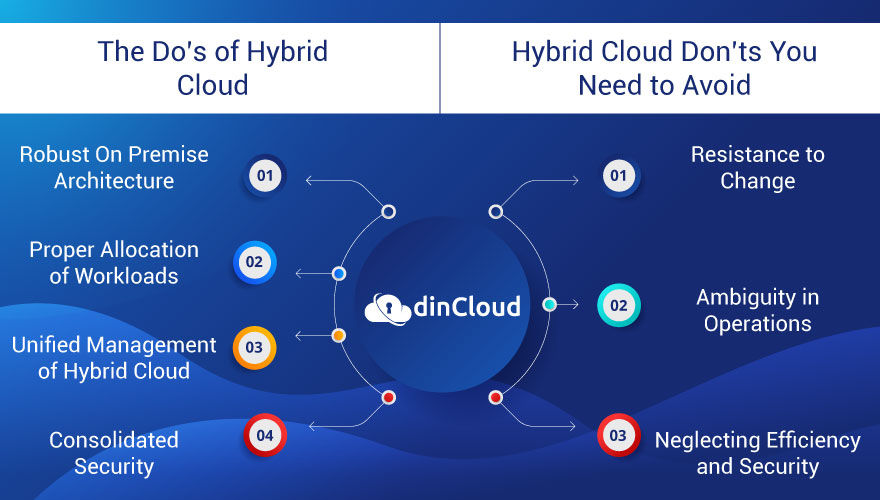With cloud computing, your deployment possibilities are nearly limitless. In the present era of a thriving cloud industry, the options for cloud users are ever expanding. However, amidst this wide choice, choosing the optimal model can at times be challenging.

Among the many cloud deployment options, a hybrid cloud model tends to offer you the best of both worlds. Before we delve deep into the do’s and don’ts of a hybrid cloud, let’s first define a few characteristics of a hybrid cloud model.
What Exactly is a Hybrid Cloud?
As the name suggests, a hybrid cloud model is characterized by distributing your workloads between the on premise and public cloud infrastructure. A hybrid cloud, if deployed with proper planning, has the potential to offer you the best of both worlds.
The workloads that you manage over the on premise infrastructure offer you nearly full control over management and security, two very important considerations for sensitive workloads.
So far as other, lesser important workloads are concerned, you can allocate those workloads to a public cloud provider like dinCloud. While you enjoy relatively less control over data security and management, the cost related benefits are too good to ignore.
The Do’s of Hybrid Cloud
Now that we have covered the basics of a hybrid cloud model, let’s cover some of the do’s of this model so that you can truly avail the underlying benefits.
Robust On Premise Architecture
In a hybrid cloud model, most of the heavy lifting in terms of mission critical workloads will be handled by your on premise infrastructure. Therefore, it is imperative that the on premise architecture is robust and amply quipped to handle critical workloads effectively.
Proper Allocation of Workloads
Workload allocation is a very important aspect of any hybrid cloud environment. You will have to evolve a systematic mechanism whereby workloads will be channelized either to the on premise / private cloud or the public cloud infrastructure.
Also Read:
- 10 Factors to Consider Before Migrating to the Hybrid Cloud
- Hybrid Cloud Outlook for Year 2020
- Recap of Cloud Computing in 2019 and Outlook for 2020
Unified Management of Hybrid Cloud
While you will be allocating workloads between the on premise and public cloud infrastructures, you still need to consolidate the management function. It is absolutely vital that you use a single cloud management solution for your hybrid environment.
This in turn will not only simplify and optimize the management part, it will also enable you to manage the hybrid cloud environment much more effectively. This step will go a long way in removing integration related issues and bottlenecks.
Consolidated Security
While this may seem a bit challenging to implement and execute, it can go a long way in improving the cyber security profile of your hybrid cloud environment. While your public cloud provider will take care of its own security, you can still adopt a single solution.
Public cloud providers like dinCloud are exposed to a much broader spectrum of cyber threats and by cloning the best security practices of a public cloud for the on premise security, you are implementing a tried and trusted formula that is nearly fail safe.
Hybrid Cloud Don’ts You Need to Avoid
Now that we have covered some of the things you should be doing in an effective hybrid cloud, let’s discuss a few things you should steer clear of to attain a secure and powerful hybrid cloud environment.
Resistance to Change
Any fresh deployment is bound to bring about some traditional resistance to change, which is quite expected in the first place. Therefore, you have to overcome the initial resistance to a hybrid cloud environment, especially when the benefits are yet to become visible.
Ambiguity in Operations
This can be a defining aspect of any hybrid cloud environment. There should be absolute clarity in what should be the deciding features of the deployment model. Try to eliminate any ambiguity upfront so that every stakeholder is aware of its responsibilities.
Neglecting Efficiency and Security
For any hybrid cloud to deliver the desired level of performance, you have to strike a reasonable balance between efficiency and security. A deployment that is too focused on efficiency, while compromising on security is not at all acceptable.
Similarly, if you become too preoccupied with the security aspect, it is quite possible that you choke the whole infrastructure. This will ultimately result in a deteriorated end user experience that will become counter productive instead of the desired benefits.
Also Read:
- dinCloud’s Public, Colo, Private & Hybrid Offerings
- Cloud Orchestration & Management Platform by dinCloud – dinManage
- 3 Things Every Small Business Can Do With Hybrid BPM and RPA
- Why Multi Cloud Computing Is Better Than Hybrid Cloud Computing?
Conclusion
A hybrid cloud environment has the potential to deliver the best of both on premise or private cloud and that of the public cloud. If you follow the above do’s and don’ts in true letter and spirit, you will be able to realize a hybrid cloud that’s secure and efficient.
Although dinCloud specializes in the public cloud solutions, our team of highly professional cloud experts is all ears for any hybrid cloud environment you may be interested in deploying. To accomplish this task, dinCloud’s professionals will need a detailed overview.
Once we have fully contemplated your hybrid cloud needs, our team of highly skilled cloud professionals should be in a much effective position to design a hybrid cloud environment that delivers the control of a private cloud and cost efficiencies of the public cloud.


